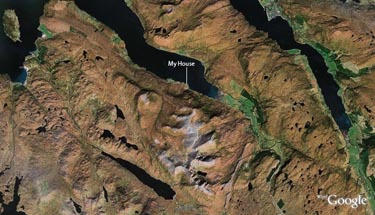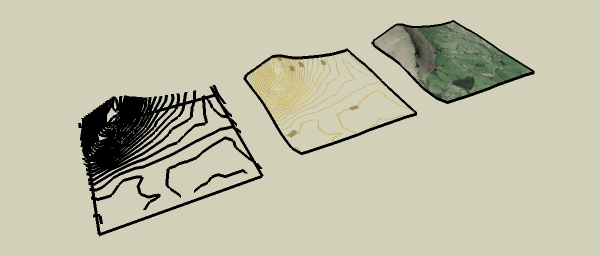Procedural terrains
-
I would also believe Z-brush to be the best option. Vue has more mapping tools than SU and others alike but by no means a true solution.
-
Just to chime in here and show there is some more interest in this process. We are doing stuff like this more and more and I for one would love to see a tutorial on this process. Time usually doesn't permit us to do the freeform thing and we end steping the contours from survey data or traced images.
I guess my real question is: Are you getting an accurate "dem" image from GE to use as a displacement map or is this more of an "artistic guess" at landscaping. Either way you are certainly on to something here. If someone could build a displacement map routine ruby for sketchup I'm not sure I would need autocad anymore.
-
Fossa,
I would not say it's an artistic approximation but more of a primary image limitation, see the images I get from GE have shadows and the shadows are a very instrumental in getting the displacement map accurate. I have not yet tried using the new GE sun positioning feature yet and will in due coarse try different settings. ( I will continue with this in a few days , as soon as my current project completes).
I agree a terrain generator ruby would be awesome and another reason to not use those $$$ apps and keep the workflow down to a single app. -
Soooooo much to learn...nice work (again!), Pete. Will be watching close for that tut as well as I just today got a small house project where a stone outcrop is the prominent and center feature of the site. The architect wants to have it poke thru a deck and maybe a little of the floor structure to the inside (at a fireplace)...should be a fun model to build but it will have to look better than what I've done before: so perfect timing!
-
excuse me a sec while i pick my jaw up off the floor.
that is the most amazing terrain model, or any organic model for that matter, i have ever seen.
that was a genius idea to use the terrain tool + subd and smooth. i never would have thought of that. you have, once again, succeded in making me feel like a begginer. -
Have you done any experimenting with Heightfield ruby? Where displacement is done by a grey scale image. The darker areas are the lowest point and the highest point are light.
-
lapx, I have not, sounds like the kinda thing I may be very interested in trying. got a link?
-
hi lapx
what is the height field ruby?
-
Hi Pete
although this is off topic I had to reply
Opened the forum today & was amazed to see a photo of where I live. Any reason you picked this area of Scotland or was it just random? Small world eh.
Cheers Dave

-
Hi Guys,
heightfield_gen.rb by Didier (scroll down to find it - I didn't want to link the ruby/text file itself).
On another note, you may also be interested in the Cloud_V6 (i.e. SU 6) plugin also by Didier if you have a bunch of points (xyz coordinates) surveyed at a site.
However all this you are doing here, Pete, is really impressing and awsome. I think even Google would be interested!

-
Thanks Gaieus, I will look into them as soon as I am done current assignment.
I did not know this ruby existed, brings me to the conclusion that i need to look into what is out there that may have been overlooked or older ruby's that could be more relevant now with all the added capabilities we have maybe there are some gems out there that could be better used now.
-
This is fantastic.
I think terrains are were a lot of us struggle getting good/accurate results.
This could be a massive help to many. -
Pete,
Great work.
I believe You started this thread in search of
information. Now we are left waiting for a tutorial.
-
Thanks for the assist Gaieus. I could never get that Heightfield to work with anything of significant size. This was some time ago, I gave up
 Maybe it's improved by now. It's in the right hands now. Here are some old links for more background:
Maybe it's improved by now. It's in the right hands now. Here are some old links for more background:
http://groups.google.com/group/sketchup-Pro-Groups/search?group=sketchup-Pro-Groups&q=heightfield -
What would happen if you apply this technique to the Grand Canyon... that would be interesting to see....
-
I gave it (the hieghtfield ruby) a shot using a .raw and .ppm image of the Grand Canyon but after the drop box dialog appears nothing happened, no mesh nada, whats up with that?
-
Probably doesn't help much, but here are my thoughts on this...
One thing I notice from your experiments with GE images is that the end mesh is not accurate (in my opinion).
Particularly noticable to me is your first ge image of scotland. The lochs appear to have very steep sides, which may be correct in some instances, but also the lighter coloured area is a mountain (An Teallach I believe) but there does not seem to be much height difference relative to its surroundings as I would expect.
I assume that the mesh is generated by colour of the ge image??
ge/gmaps does seem to have detailed elevation data (google map showing part of the same area of scotland showing terrain with contours), but it doesn't seem like this can be easily exported.
I attempted extracting these contours with raster to vector software, but needed quite a bit of time to tidy up to be of use, although the end result seemed reasonably accurate, especially with the gmaps satellite image added as a texture.
I will keep an eye on how this progresses (particularly if you are trying to create an accurate model)
-
rsw,
You are correct the hieghts are not correct, I am battling to get good source images, the ones you linked above are much better and I will give that a go tomorrow.
I will keep at it to the point that I either succeed or a better idea comes from it.Below I used a photo and tried the straight .jpg to displacement method, it is not accurate but still a pretty cool looking result.

Source image

The hidden line mesh 67000 faces.

result.
-
@solo said:
Fossa,
I would not say it's an artistic approximation but more of a primary image limitation, see the images I get from GE have shadows and the shadows are a very instrumental in getting the displacement map accurate.
Just curious, but have you tried using the Micro$oft Live Maps? They seem to have less shadows. Just click on the aerial button to get the image. http://maps.live.com/?mkt=en-us Just a thought.
-
@solo said:
Below I used a photo and tried the straight .jpg to displacement method, it is not accurate but still a pretty cool looking result.
Definitely a cool result, and very interested in how you are getting from the jpg to the su mesh.
Had another go at extracting the contours from google maps terrain images, with the following result:

Tidying up and assigning heights to each contour is tedious for large areas but not bad for smaller sections. I used the contour maps from http://www.earthtools.org/ which are in metres rather than googles which are in feet. This says that these contours were generated from data, if we could find out how the contours are generated maybe they could be imported straight into su...
Advertisement









